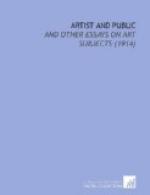Do not be deceived. This is not vital art, it is decadent and corrupt. True art has always been the expression by the artist of the ideals of his time and of the world in which he lived—ideals which were his own because he was a part of that world. A living and healthy art never has existed and never can exist except through the mutual understanding and co-operation of the artist and his public. Art is made for man and has a social function to perform. We have a right to demand that it shall be both human and humane; that it shall show some sympathy in the artist with our thoughts and our feelings; that it shall interpret our ideals to us in that universal language which has grown up in the course of ages. We have a right to reject with pity or with scorn the stammerings of incompetence, the babble of lunacy, or the vaporing of imposture. But mutual understanding implies a duty on the part of the public as well as on the part of the artist, and we must give as well as take. We must be at the pains to learn something of the language of art in which we bid the artist speak. If we would have beauty from him we must sympathize with his aspiration for beauty. Above all, if we would have him interpret for us our ideals we must have ideals worthy of such interpretation. Without this co-operation on our part we may have a better art than we deserve, for noble artists will be born, and they will give us an art noble in its essence however mutilated and shorn of its effectiveness by our neglect. It is only by being worthy of it that we can hope to have an art we may be proud of—an art lofty in its inspiration, consummate in its achievement, disciplined in its strength.
II
JEAN FRANCOIS MILLET
Jean Francois Millet, who lived hard and died poor, is now perhaps the most famous artist of the nineteenth century. His slightest work is fought for by dealers and collectors, and his more important pictures, if they chance to change hands, bring colossal and almost incredible prices. And of all modern reputations his, so far as we can see, seems most likely to be enduring. If any painter of the immediate past is definitively numbered with the great masters, it is he. Yet the popular admiration for his art is based on a I misapprehension almost as profound as that of those contemporaries who decried and opposed him. They thought him violent, rude, ill-educated, a “man of the woods,” a revolutionist, almost a communist. We are apt to think of him as a gentle sentimentalist, a soul full of compassion for the hard lot of the poor, a man whose art achieves greatness by sheer feeling rather than by knowledge and intellect. In spite of his own letters, in spite of the testimony of many who knew him well, in spite of more than one piece of illuminating criticism, these two misconceptions endure; and, for the many, Millet is still either the painter of “The Man with the Hoe,” a powerful but somewhat exceptional work, or the painter of “L’Angelus,” precisely the least characteristic picture he ever produced. There is a legendary Millet, in many ways a very different man from the real one, and, while the facts of his life are well known and undisputed, the interpretation of them is colored by preconceptions and strained to make them fit the legend.




